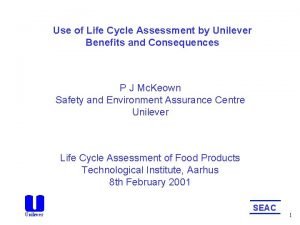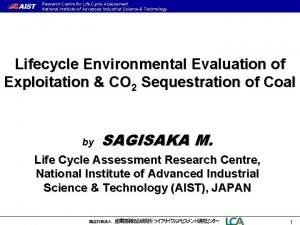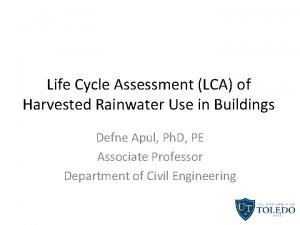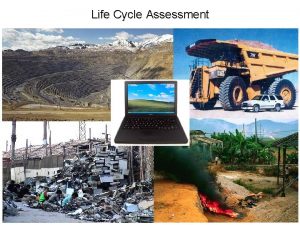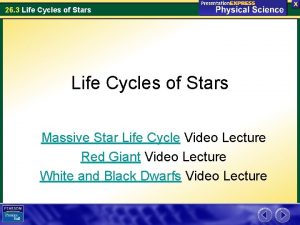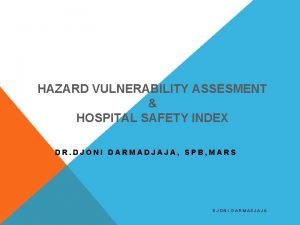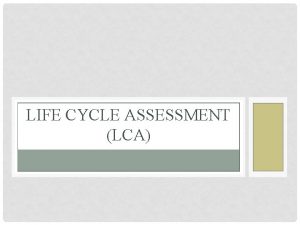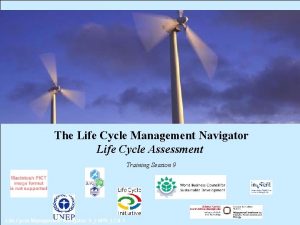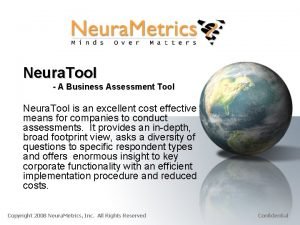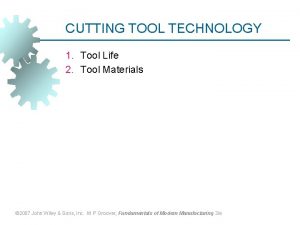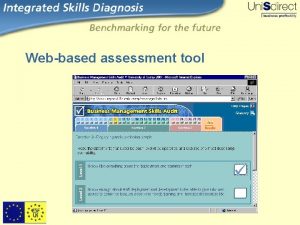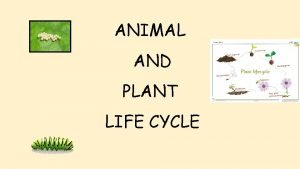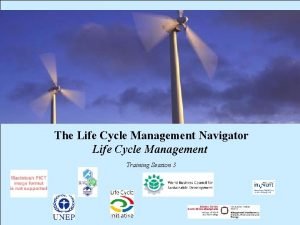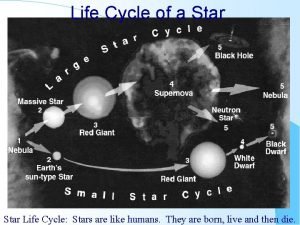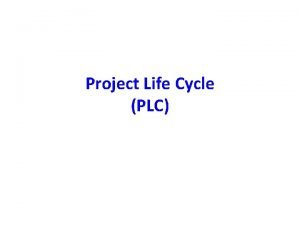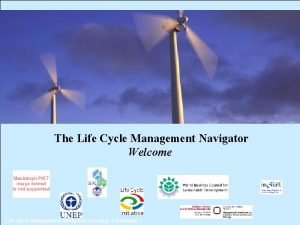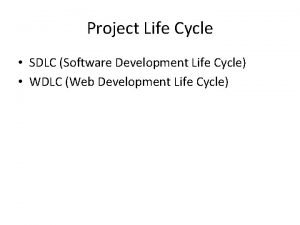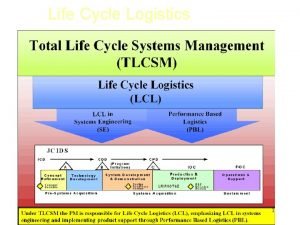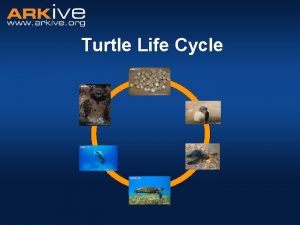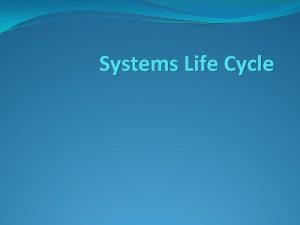Life Cycle Assessment A Tool for Evaluating and


































































- Slides: 66

Life Cycle Assessment: A Tool for Evaluating and Comparing Different Treatment Options for Plastic Wastes G. Dodbiba 1, K. Takahashi 1, T. Furuyama 2, J. Sadaki 1, T. Kamo 3, and T. Fujita 1 1. Department of Geosystem Engineering, The University of Tokyo, Japan 2. Department of Earth Resource Engineering, Kyushu University, Japan 3. National Institute of Advance Industrial Science and Technology, Japan

Outline 1. LCA Methodology (ISO 14040) 2. LCA of Plastic Wastes from Discarded TV Sets 3. Concluding Remarks

Outline 1. LCA Methodology (ISO 14040) 2. LCA of Plastic Wastes from Discarded TV Sets 3. Concluding Remarks

Scope of LCA … to evaluate or compare the life cycle of “products”

Life-Cycle Stages and Boundaries (Source: Source EPA, 1993)

Methodology: Life Cycle Assessment, (ISO 14040) Phase 1: Definition of products; Choice of alternatives; Definition of system boundary; Phase 2: Data collection; Theoretical calculation; Phase 3: Phase 4: Evaluation Reporting the results; Propose improvement; (Source: Source Consoli et. al. , 1993)

Aim of Study … to evaluate and compare different recycling options for plastic wastes from old TV sets in context of LCA

Compositions of a TV Set (weight %) (Source: Source O. Murakami, Mitsubishi Elec. ADVANCE, pp. 6 -9, 2001).

Conventional Recycling System for TV sets Source: Association for Home Electrical Appliances of Japan http: //www. aeha. or. jp/assessment/en/english_flame. html Problem: How to recycle plastic wastes?

Objective … to compare two different recycling options for plastic wastes from old TV sets in context of LCA Option 1: Incineration of plastics for energy recovery (also known as thermal recycling) Option 2: Sorting plastics for mechanical recycling (also know as material recycling)

Outline 1. LCA Methodology (ISO 14040) 2. LCA of Plastic Wastes from Discarded TV Sets 3. Concluding Remarks

Methodology: Life Cycle Assessment, (ISO 14040) Phase 1: (Source: Source Consoli et. al. , 1993) Definition of products; Choice of alternatives; Definition of system boundary;

Phase 1 of LCA: LCA Goal Definition and Scope a. Subject of the study are plastic wastes from old TV sets (display: 25”, weight = 30 kg), which contain: 1. PS (6. 0 wt%, i. e. 1. 80 kg), 2. PVC (3. 5 wt%, i. e. 1. 05 kg), 3. PE (1. 0 wt%, i. e. 0. 30 kg). b. Functional unit: is defined as 1. 8 million TV sets per year, over a period of 10 years.

Life-cycle of plastics for TV sets Special cases: (1). Energy recovery, i. e. c = 0 %; (2). Mechanical recycling, i. e. c = 100 % and r = 67 %

Methodology: Life Cycle Assessment, (ISO 14040) Phase 2: (Source: Source Consoli et. al. , 1993) Data collection; Theoretical calculation;

Phase 2 of LCA: Inventory analysis a) Data collection The data of the processes, namely: 1. production of PS, 2. production of PVC, 3. production of PE, 4. production of electricity, 5. production of a TV set, were from the LCA database of the Japan Environmental Management Association for Industry (JEMAI). JEMAI

Phase 2 of LCA: Inventory analysis a) Data collection Option 1: Incineration of 1 kg plastic material Energy generated: PS – 9, 604 kcal/kg PVC – 4, 300 kcal/kg PE – 11, 140 kcal/kg Source: K. Krekeler et al. , Kunstsoffe, 55/10, pp. 758, 1965 Emission: 2, 640 g CO 2 /kg Source: Ministry of Environment of Japan, Guidelines, 2004

Option 2: 2 Separation of plastic wastes prior to mechanical recycling Plastics Density, [kg/m 3] PS 1050 PE 960 PVC 1 st Step 1400 2 nd Step

Phase 2 of LCA: Inventory analysis a) Data collection Option 2: 2 Separation of plastic wastes (by combining triboelectric separation and air tabling) Energy: Triboelectric separator Air table Size reduction Sieving Recovery of products: Grade of products: 0. 74 k. Wh/kg 0. 04 0. 66 0. 02 67 % > 95 % k. Wh/kg

Phase 2 of LCA: Inventory analysis b) Theoretical calculations g is the vector of the environmental interventions the matrix A represents the flow of products and materials the matrix B represents the flow of environmental loads the vector f represents a special process where the functional unit is an output Steps to be followed in theoretical calculation: 1. Calculate the inverse of matrix of A (i. e. A-1) 2. Calculate the inventory vector g

Methodology: Life Cycle Assessment, (ISO 14040) Phase 3: (Source: Source Consoli et. al. , 1993) Evaluation

Phase 3 of LCA: LCA Impact assessment The categories of the environmental impacts: a) Abiotic resources: ADP (in kg Sb eq. ) b) Global warming: GWP (in kg CO 2 eq. )

Phase 3 of LCA: Impact assessment a) Depletion of Abiotic Resources, (ADP)

Phase 3 of LCA: Impact assessment a) Depletion of Abiotic Resources, (ADP) 1. 6 x

Phase 3 of LCA: Impact assessment b) Global Warming Potential (GWP)

Phase 3 of LCA: Impact assessment b) Global Warming Potential (GWP) 1. 4 x

Methodology: Life Cycle Assessment, (ISO 14040) Phase 4: (Source: Source Consoli et. al. , 1993) Reporting the results; Propose improvement;

Phase 4 of LCA: Main Results Environmental Impact 1. 5 x

Outline 1. LCA Methodology (ISO 14040) 2. LCA of Plastic Wastes from Discarded TV Sets 3. Concluding Remarks

Concluding Remarks n The energy recovery (option 1) 1 and the mechanical recycling (option 2) 2 of plastic wastes from the discarded TV sets were compared in the context of LCA n The energy recovery is an treatment option that generated more energy due to the incineration of plastic wastes. Nevertheless, this option also uses more resources and emits a larger quantity of greenhouse gases. n The separation of plastics for mechanical recycling is more effective alternative, because it consumes fewer energy and resources, as well as has a lower environmental impact on global warming.




Conventional Recycling System for TV sets Source: Matsushita Eco Technology Center (METEC) Available from internet: http: //panasonic. co. jp/eco/en/metec/tv/material 2 -1. html

Three alternatives are being considered when dealing with plastic wastes: 1. energy recovery (also known as thermal recycling), i. e. direct incineration of plastic wastes for energy recovery 2. mechanical recycling (also known as material recycling), i. e. the method by which plastic wastes are recycled into new resources without affecting the basic structure of the material; 3. feedstock recycling (also known as chemical recycling), i. e. the technique that break down polymers into their constituent monomers, which in turn can be used again in refineries or petrochemical and chemical production.

Required Purity of Sorted Plastics for Reuse (courtesy of KINKI KOGYO Co. Ltd. , Japan) Reuse of plastics in circulating system as low grade plastics : > 95. 0 % Reuse of plastics in circulating system as virgin plastics : > 99. 5 % Reuse of plastics for agricultural, horticultural industry, etc. : > 99. 0 % Use of plastics as oxidant in blast furnaces : < 1. 0 % (PVC impurity)

Life Cycle Assessment Framework (Source: Source LCA, ISO 14040)

Bond’s Method: Size-reduction Wi = 13. 81 k. Wh/t DP = 2. 63 mm DF = 5. 00 mm

Production of 1 kg PS (Source: JEMAI-LCA On-line Database)

Production of 1 kg PVC (Source: JEMAI-LCA On-line Database)

Production of 1 kg PE (Source: JEMAI-LCA On-line Database)

Production of 1 k. Wh Electricity (Source: JEMAI-LCA On-line Database)

Production of a TV set (Sources: a. JEMAI-LCA On-line Database; b. Murakami, 2001)

Matrix B of Environmental interventions

Demand vector, f

Technological Matrix, A


Structure of LCA model

After choosing the FINAL DEMAND of the product, the simplest UNIT PROCESS can be written as follows: INPUT (product flow) x (scaling parameter) = (final demand) OUTPUT (environmental flow) x (scaling parameter) = (environmental intervention) Ref. : Leontief, 1970 (Winner of Nobel Prize in 1973)

Inventory data Technology matrix; A Input ( - ) Process Output ( + ) Final demand vector; f Process 1… … …Process n Technological parameters Emission from the process Environmental intervention matrix; B ? ? Inventory; g

Linear programming (Heijung et. al, 2002) Product flow, a Scaling parameter, s Demand, f Environmental flow , b Environmental intervention , g

Equations can be written in terms of matrixes

Technology matrix Final demand vector Scaling vector Intervention matrix Inventory vector

Linear programming / Matrix manipulation (Heijung et. al, 2002) Final demand vector Inverse matrix of technology matrix A Scaling vector Solution: Inventory vector Environmental intervention matrix

LCI Results – g vector The outcome of the inventory analysis was the vector g, which is a list of the quantities gi of pollutants released to the environment and the amount of energy and materials consumed during the life-cycle of plastics for TVs production (Matrix B), i. e. : for i = 1, 2, … , n

Phase 3 of LCA: LCA Impact assessment The categories of the environmental problems: a) b) c) d) e) f) Resource depletion/Abiotic depletion ADP (in kg Sb eq. ) Global warming – GWP (in kg CO 2 eq. ) Acidification, AP (in kg SO 2 eq. /kg) Photo-oxidant formation, POCP (in kg C 2 H 4 eq. /kg) Eutrophication, EP (in kg PO 4 eq. /kg) Human toxicity, HTP (in kg 1, 4 -DCB eq. /kg)

How to calculate the environmental impact? The impact indicator Ij of each category was calculated after all the environmental loads gi within a category were characterized and aggregated using the following equations, Results of LCI, g vector

Characterization factors, ki(j) Source: Handbook of LCA, 2002

Normalization The indicator Ij of each environmental impact category is divided by a reference value known as normalization factor wj q indicates the number of the environmental impact categories.

Weighting factors, ki Source: Handbook of LCA, 2002 World (1995) kg (Sb eq. ) ∙ yr-1 ADP 1. 57 ∙ 1011 GWP 3. 86 ∙ 1013 kg (CO 2 eq. ) ∙ yr-1 AP 2. 99 ∙ 1011 kg (SO 2 eq. ) ∙ yr-1 POCP 4. 55 ∙ 1010 kg (C 2 H 4 eq. ) ∙ yr-1 EP 1. 29 ∙ 1011 kg (PO 4 eq. ) ∙ yr-1 HTP 4. 98 ∙ 1013 kg (1, 4 -DCB eq. ) ∙ yr-1

Phase 3 of LCA: Impact assessment a) Energy Depletion (ED) 3 x 1. 4 x

Comparing energy recovery (option 1) with mechanical recycling (option 2) Environmental Indicators Energy balance (ED), in [kcal] Abiotic depletion potential (ADP), in [kg Sb. eq. ] Global warming potential (GWP), in [kg CO 2 eq. ] Option 1, (Energy recovery) Option 2, (Mechanical recycling) -158, 808, 456, 261 -186, 049, 047, 033 1, 143, 091 698, 156 452, 329, 521 334, 977, 313

An Estimate for the Environmental Burden (EEB)

3. 4. 3. Sensitivity Analysis - perturbation method (Matrix of Environmental Load, g) where:

Sensitivity Analysis Scenarios for: a. saving resources (ADP), and b. reducing the greenhouse gas emission (GWP)

3. 4. 4. Strategy to reduce the environmental burden 1. Collect as many TV sets as possible 2. Use PS instead of PVC or PE for production of TV sets (i. e. possibly excluding PVC) 3. 4. in turn: 5. a. The efficiency of the separation process will be improved reducing the ADP indicator, b. The emission of CH 4 and CO 2 will be reduced (i. e. GWP)
 Whole building life cycle assessment wblca
Whole building life cycle assessment wblca Unilever supply chain strategy
Unilever supply chain strategy Life cycle assessment
Life cycle assessment Life cycle assessment of rainwater harvesting
Life cycle assessment of rainwater harvesting Life cycle assessment
Life cycle assessment Life cycle of a star assessment
Life cycle of a star assessment Hospital safety index adalah
Hospital safety index adalah Potter's tool is data cleaning tool
Potter's tool is data cleaning tool Kontinuitetshantering
Kontinuitetshantering Typiska novell drag
Typiska novell drag Tack för att ni lyssnade bild
Tack för att ni lyssnade bild Ekologiskt fotavtryck
Ekologiskt fotavtryck Varför kallas perioden 1918-1939 för mellankrigstiden
Varför kallas perioden 1918-1939 för mellankrigstiden En lathund för arbete med kontinuitetshantering
En lathund för arbete med kontinuitetshantering Underlag för särskild löneskatt på pensionskostnader
Underlag för särskild löneskatt på pensionskostnader Tidbok
Tidbok Anatomi organ reproduksi
Anatomi organ reproduksi Vad är densitet
Vad är densitet Datorkunskap för nybörjare
Datorkunskap för nybörjare Boverket ka
Boverket ka Hur skriver man en debattartikel
Hur skriver man en debattartikel Delegerande ledarstil
Delegerande ledarstil Nyckelkompetenser för livslångt lärande
Nyckelkompetenser för livslångt lärande Påbyggnader för flakfordon
Påbyggnader för flakfordon Vätsketryck formel
Vätsketryck formel Offentlig förvaltning
Offentlig förvaltning Jag har nigit för nymånens skära
Jag har nigit för nymånens skära Presentera för publik crossboss
Presentera för publik crossboss Vad är ett minoritetsspråk
Vad är ett minoritetsspråk Plats för toran ark
Plats för toran ark Treserva lathund
Treserva lathund Luftstrupen för medicinare
Luftstrupen för medicinare Bästa kameran för astrofoto
Bästa kameran för astrofoto Cks
Cks Programskede byggprocessen
Programskede byggprocessen Bra mat för unga idrottare
Bra mat för unga idrottare Verktyg för automatisering av utbetalningar
Verktyg för automatisering av utbetalningar Rutin för avvikelsehantering
Rutin för avvikelsehantering Smärtskolan kunskap för livet
Smärtskolan kunskap för livet Ministerstyre för och nackdelar
Ministerstyre för och nackdelar Tack för att ni har lyssnat
Tack för att ni har lyssnat Referatmarkeringar
Referatmarkeringar Redogör för vad psykologi är
Redogör för vad psykologi är Matematisk modellering eksempel
Matematisk modellering eksempel Atmosfr
Atmosfr Borra hål för knoppar
Borra hål för knoppar Orubbliga rättigheter
Orubbliga rättigheter Formel för standardavvikelse
Formel för standardavvikelse Tack för att ni har lyssnat
Tack för att ni har lyssnat Steg för steg rita
Steg för steg rita Vad är verksamhetsanalys
Vad är verksamhetsanalys Tobinskatten för och nackdelar
Tobinskatten för och nackdelar Toppslätskivling dos
Toppslätskivling dos Gibbs reflekterande cykel
Gibbs reflekterande cykel Egg för emanuel
Egg för emanuel Elektronik för barn
Elektronik för barn Antika plagg
Antika plagg Strategi för svensk viltförvaltning
Strategi för svensk viltförvaltning Kung dog 1611
Kung dog 1611 Humanitr
Humanitr Sju för caesar
Sju för caesar Tack för att ni lyssnade
Tack för att ni lyssnade Enheter för massa
Enheter för massa Bunden till c-dur
Bunden till c-dur Inköpsprocessen steg för steg
Inköpsprocessen steg för steg Fuktmätningar i betong enlig rbk
Fuktmätningar i betong enlig rbk Ledarskapsteorier
Ledarskapsteorier

